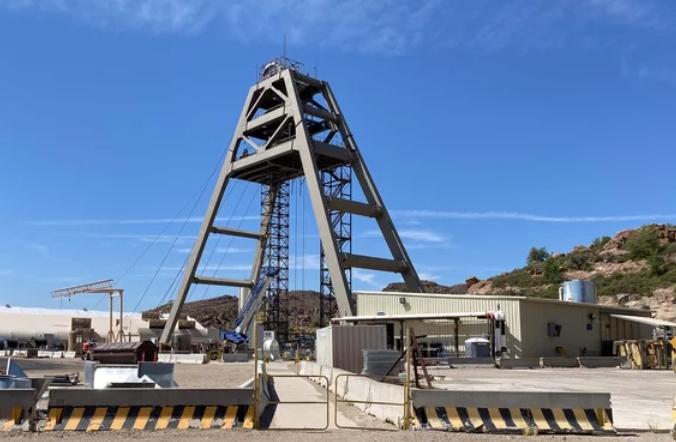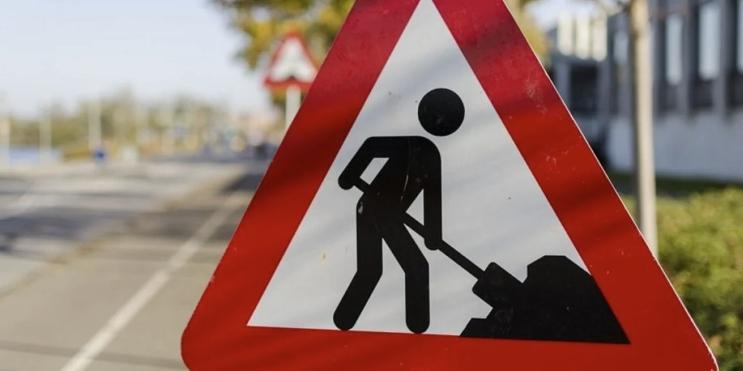On a scorching morning amidst the mountainous terrain east of Phoenix, a miner adorned in a sturdy hard hat descends a shaft that plunges nearly 7,000 feet into the earth. This mine, which has the potential to become the largest underground copper mine in the United States, is currently not extracting copper. Instead, it is actively removing groundwater at a rate of approximately 600 gallons per minute.
The reason for this lies in the profound depth at which the copper deposits are found, nestled within geological formations that trace their origins back over a billion years. Consequently, mining operations are conducted well below the water table to prevent flooding. Remarkably, the Resolution Copper mine is generously providing this extracted aquifer water at no cost to neighboring farmers, contributing around 6 billion gallons of water to date.
This summer, Arizona state authorities announced their decision to withhold approval for certain new housing projects in the Phoenix area due to concerns regarding groundwater availability. The groundwater resources in this region are facing escalating pressure due to prolonged drought and the effects of climate change. Ironically, it is within this very Phoenix metropolitan area that Resolution intends to extract groundwater to support its mining operations. Provided the mine secures the necessary environmental permits and commences full-scale operations, Resolution anticipates utilizing vast quantities of local groundwater and stored Colorado River water over the course of the next four decades.
The United States is actively pursuing the establishment of new domestic sources for critical metals like copper, lithium, and manganese, which are essential for manufacturing products such as electric vehicle batteries, solar panels, and various components integral to the transition from fossil fuels to clean energy. However, a significant portion of mineral exploration and planned production is concentrated in the arid American West, where water resources are progressively becoming scarcer.
Mines such as Resolution claim to employ innovative technologies aimed at reducing water consumption during mineral extraction and processing. However, concerns persist among researchers and Indigenous groups regarding the repercussions of depleting local aquifers as an integral part of mining activities, including potential adverse effects on local water quality. Critics argue that the water usage within Arizona’s mining sector is inadequately regulated, with much of the data on water consumption being self-reported by companies.
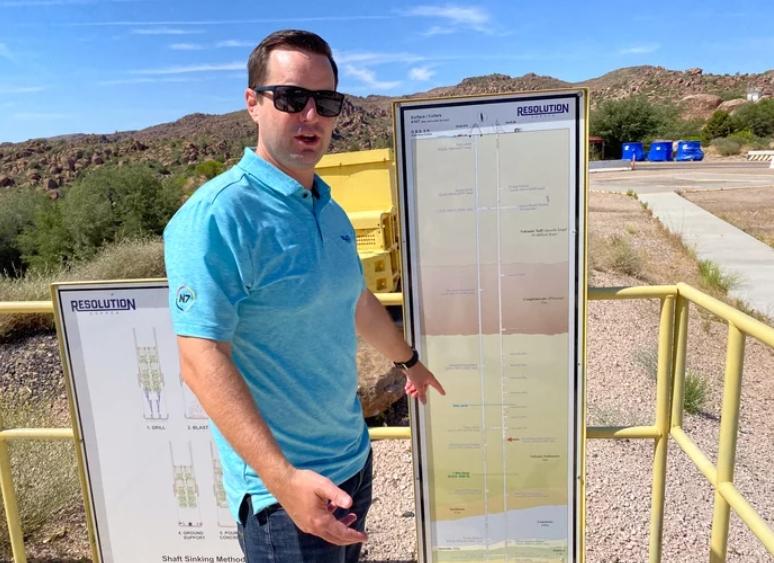
In the current landscape marked by the intertwining challenges of climate change and dwindling water resources, there is a growing collision between the imperative to unearth the West’s essential minerals for the energy transition and the pressing need to safeguard the remaining water supply. Burke Griggs, a law professor at Washburn University School of Law specializing in Western water law, underscores this conundrum, stating:
“The predominant challenge confronting us in the West regarding these critical minerals is the availability of water necessary to make mining of these vital minerals economically viable.”
Griggs emphasizes the gravity of the situation, remarking:
“The stakes could not be higher, because once groundwater is depleted, its restoration is unlikely to occur in the foreseeable future.”
Green tech mining brings up concerns about water scarcity and quality
Water plays a crucial role in mining operations, serving purposes such as metal processing and dust control. When working in deep underground mines, companies often extract aquifer water to prevent flooding. Additionally, the production of lithium, especially through the use of large evaporation ponds, can significantly increase water usage.
Many Western states, grappling with diminishing aquifers, are witnessing substantial investments in new mining ventures aimed at supplying the burgeoning green technology sector. States like Arizona, California, Nevada, and Utah are actively exploring and developing new lithium projects. Furthermore, Arizona and Utah are channeling investments into new copper projects, while the federal government is expediting the permitting process for a manganese and zinc project located south of Tucson, Arizona.
These metals hold pivotal roles in climate solutions. Lithium and manganese are essential components in electric vehicle batteries and batteries designed for storing renewable energy. Copper is a vital element in electric vehicles, and both copper and its mining byproduct, tellurium, are integral to the production of solar panels and various other green technologies.
As the shift away from fossil fuels gains momentum, the demand for these minerals may surpass the available supply. According to the Net Zero by 2050 scenario proposed by the International Energy Agency, the world will require 50% more copper than current supplies can provide to meet projected demand by 2030. Additionally, the International Energy Agency predicts that by 2030, the demand for lithium will be five times greater than the current global supply. Susan Zou, Vice President at Rystad Energy, a research company, suggests that ensuring domestic supplies of manganese could become a challenge for the U.S. unless investments are made in local mines or processing facilities.
Resolution Copper, a joint venture of mining giants Rio Tinto and BHP, has the potential to contribute significantly to these mineral supplies. Vicky Peacey, President of Resolution Copper, notes that their operations could yield a quarter of the current U.S. copper production and double the U.S. tellurium supply. She emphasizes that deposits like theirs can help bridge the supply-demand gap but acknowledges the importance of adopting a different approach. Their underground mining method involves reduced water usage and aligns with the imperative for electrification, ensuring that their operations align with societal expectations.
The treated aquifer water extracted by Resolution presently benefits local farmers, primarily supporting the cultivation of alfalfa for dairy farms, according to Bill Van Allen, Assistant General Manager of the New Magma Irrigation & Drainage District situated southeast of Phoenix. Van Allen remarks:
“Affordable water is a rarity, and free water is even rarer.”
In the future, Resolution intends to redirect this water for ore processing. Vicky Peacey mentions that the mine will incorporate advanced technology to enhance water recycling efforts. She affirms:
“We have committed to a complete overhaul of some of our facilities, with the goal of reducing water consumption.”
However, hydrologists and mining experts express concerns about the potential repercussions of the mining operations and the disposal of mine waste on the nearby streams and aquifers, as well as the substantial quantities of water that the mine will extract from the arid desert. Resolution’s adoption of the “block cave mining” method will initiate a phenomenon known as subsidence, where the land sinks due to the removal of ore from the underground deposit. This subsidence will result in the formation of a crater approximately 2 miles wide and 1,000 feet deep, which will inevitably impact the aquifer, warns James Wells, an environmental geologist providing consultation for the San Carlos Apache Tribe, an opponent of the project. Wells explains:
“If a perforation is made through that aquifer in that location, it would effectively obliterate the aquifer. Moreover, the water that would typically have flowed through that region will now simply pour into the cavity, preventing it from reaching its intended destination.”
According to Wells, the impacts on water flow will be readily visible across the desert landscape. He emphasizes:
“This region is exceptionally arid, and the presence of springs and perennial streams holds immense ecological significance. These water sources are not only critical habitats but also carry profound cultural importance for the local tribes as sacred sites.”
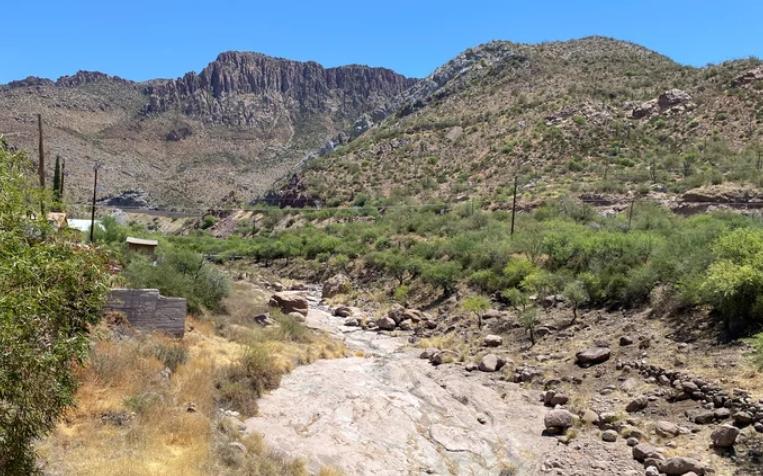
Local residents are also expressing apprehension regarding Resolution’s intentions to store mine waste in a valley. Furthermore, there are concerns about the possibility of discharging treated wastewater into Queen Creek, which had already suffered from historical copper mining contamination. In response, the San Carlos Apache Tribe initiated legal action, asserting that releasing treated waste into the creek would constitute a violation of the Clean Water Act. The tribe achieved victory on appeal, and Resolution is currently pursuing an appeal with the Arizona Supreme Court.
However, one of the most significant concerns revolves around the extensive water extraction anticipated from the aquifers situated to the east of Phoenix. Although Resolution has stockpiled a portion of Colorado River water for its processing needs, the mine also intends to withdraw billions of gallons of water from the East Salt River Valley. In the 2019 preliminary environmental impact statement for the mine, the U.S. Forest Service expressed the following:
“Collectively, the overall demand for groundwater resources in the East Salt River valley is considerable and could potentially exceed the estimated available groundwater.”
A spokesperson for the mining project from Resolution acknowledged the area’s significance to local communities and ecosystems. In an email statement, they indicated that Resolution is collaborating with local tribes to minimize any adverse effects on seeps, springs, and streams by incorporating Indigenous Traditional Ecological Knowledge into the consultation process with Native American Tribes. The email also mentioned that federal agencies have conducted assessments of the mine’s aquifer pumping and have implemented a “mitigation and monitoring plan” as a precautionary measure.
Mining companies argue that domestic mineral development is crucial and that in other countries like China, the environmental consequences could be more severe. Pat Risner, the president overseeing South32’s Hermosa manganese and zinc project south of Tucson, emphasizes that the Hermosa mine will incorporate technology to curtail and recycle water, particularly in managing mine waste. He highlights South32’s commitment to adhering to stringent water discharge standards by constructing a cutting-edge water treatment facility.
Risner underscores the importance of considering trade-offs, pointing out that a substantial portion of global manganese processing occurs in China. He suggests comparing the environmental impacts and footprints of such production to that of a state-of-the-art, next-generation mine in the United States that upholds high standards.
Nevertheless, environmental advocacy groups express concerns that Hermosa may not be implementing sufficient safeguards for local water resources. One such concern revolves around the mine’s water treatment plant and its innovative approach to removing selenium, a mining-related contaminant, before discharging treated water into local streams. Ann Maest, an aqueous geochemist consulting for these groups, highlights the potential adverse effects of selenium on fish and aquatic life, emphasizing the need to balance increasing domestic metal supplies with preserving natural resources. Maest states:
“Boosting our domestic metal supply is crucial to reduce dependency on other nations. However, concurrently, we must safeguard our natural resources. In my experience, rushing can sometimes compromise careful stewardship.”
In an email statement, South32 conveyed that the Hermosa project has implemented a cutting-edge water treatment system equipped with established patented technology for selenium removal. They further emphasized their unwavering commitment to safeguarding and preserving the natural resources of the region, which includes meticulous monitoring and measurement of water-related activities.
Locals worry that state water regulations for the mining sector lag behind
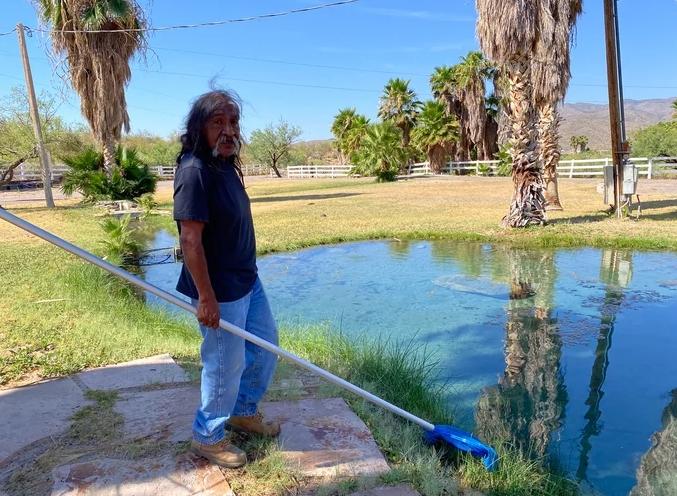
Ivan Bender strolls along a small wooden bridge at Cholla Canyon Ranch in western Arizona, employing a net to remove algae from the emerald waters of the Ha’ Kamwe’ hot springs. According to Bender, the springs possess both healing and sacred properties. He serves as the caretaker of the ranch, which is under the ownership of the Hualapai Tribe. A mere hundred yards from the tribe’s property boundary, an Australian mining company named Arizona Lithium has initiated lithium exploration activities. Bender asserts that the exploration drill holes have already caused a decrease in the spring’s flow, gesturing towards the scattered holes amid the desert shrubbery.
“When they drilled that, that’s what happened to our water,” he laments. “It went down.”
Philip Wisely, the Director of the Hualapai Tribe’s Public Service Department, voices concerns, stating:
“There’s insufficient water in this region, making it an unsuitable location for a lithium mine.”
NPR’s requests for comment from Arizona Lithium, the Australian mining company headquartered in Perth that has initiated exploration in the area, remained unanswered. The U.S. Bureau of Land Management, responsible for authorizing mining activities on public lands, clarified via email that the Australian company has merely proposed an exploration plan, not a mine, and that “no decision has been reached” at this point.
If the lithium mine proceeds in this western Arizona region, it falls outside the purview of the state’s groundwater regulations, as pointed out by Tom Buschatzke, Director of the Arizona Department of Water Resources. He notes that many parts of rural Arizona have minimal groundwater oversight.
“In essence, there is very little to no regulatory framework in that area,” Buschatzke states. “You have a shared resource with numerous users, and the impacts, whatever they may be, are not strictly controlled.”
Even within Arizona’s “active management areas” for water, including the location of the Resolution Copper mine, the mining industry enjoys exemptions from critical water regulations. Arizona’s 1980 groundwater code mandates that agriculture, industry, and construction firms must demonstrate that the water wells they drill will not adversely affect other wells. However, this requirement does not extend to mining wells.
Moreover, the state relies on mining companies to self-report their water usage, as mines are exempt from government monitoring under the law. Buschatzke explains that his department cross-references these reports over time and with similar users, conducting audits if the data submitted by mining companies appears questionable. He emphasizes that he dislikes the term “surveillance” because it implies unwarranted scrutiny, stating:
“It sort of conveys the notion of an intrusive oversight, which is not our intent. While we do have the authority to enforce regulations, our preferred approach is to collaborate with stakeholders to ensure they meet their regulatory obligations,” Buschatzke comments. “While we operate as a regulatory agency, fostering constructive relationships with water users is the most effective means of ensuring compliance with regulations.”
Regarding the matter of subsidence at the Resolution Copper mine, the Arizona Department of Environmental Quality conveyed through email that they do not conduct direct measurements of the effects of subsidence on water quality. Nevertheless, they noted that alterations in water levels could potentially influence the quality of groundwater.
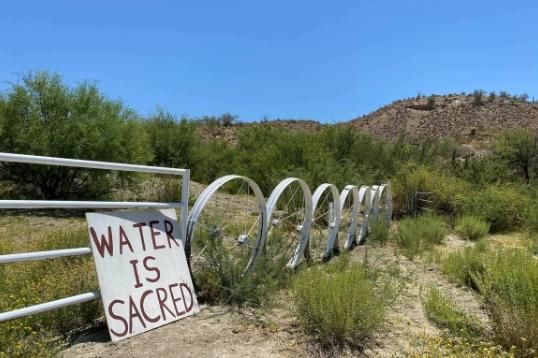
Other water-scarce regions offer warnings and solutions for the Southwest
In water-scarce regions such as the American Southwest, Chile serves as a potential indicator of what mining might entail in an increasingly arid environment, according to Christian Ihle, a professor of mining engineering at the Universidad de Chile and an executive at Shimin Engineering.
Ihle remarks, that climate change has caught the mining industry in the country somewhat off guard, highlighting that certain mining companies in Chile have been compelled to reduce their production capacities due to the dwindling water resources available in aquifers.
“Some mining companies possess permits for extracting water from aquifers, but they’re confronted with a shortage of actual water,” Ihle explains. “They have the regulatory clearance, but they lack the necessary water supply.”
The increasing water scarcity is presenting a mounting financial risk for mining enterprises, emphasizes Claire Côte, who serves as the Director of the Centre for Water in the Minerals Industry at the University of Queensland in Australia. She asserts that water availability represents a production risk for these companies, far more than an environmental concern. Côte explains:
“If they cannot secure the necessary water for their operations, production may come to a halt.”
In South America, mining ventures have been exploring novel technologies to curtail water consumption, as noted by David Snydacker, the CEO of Lilac Solutions, an American lithium technology company. Lilac Solutions, which has undertaken pilot projects in Argentina and Chile, deviates from the conventional practice of employing large evaporation ponds for lithium brine extraction. Instead, the company directly extracts lithium, a process renowned for its water efficiency. Snydacker also reveals that Lilac has plans to initiate projects in the United States in the near future, emphasizing the pivotal role of new technology in scaling up lithium production while preserving water resources.
Furthermore, the National Renewable Energy Laboratory is actively engaged in research pertaining to direct lithium extraction, as confirmed by a spokesperson.
Over the past decade, several mining operations in Chile have turned to desalination as a strategy to mitigate their environmental impact and reduce reliance on local groundwater. Notably, certain Chilean copper mines have employed extensive pipelines, some stretching over 100 miles, to transport treated ocean water inland.
In Arizona, there is participation in a multinational initiative focused on constructing desalination facilities in Mexico, which would ultimately assist in supplying water to the state. Tom Buschatzke from the Arizona Department of Water Resources mentions that the Phoenix-based mining giant, Freeport-McMoRan, plays a significant role in leading and financing this project.
“We haven’t yet determined the recipients of this water,” Buschatzke explains. “However, Freeport’s active involvement suggests that they anticipate benefiting from this water source.”
A spokesperson from Freeport-McMoRan clarified in an email, stating:
“Up to this point, Freeport’s involvement in the Bi-National Desalination Study has been solely in the form of financial contributions. While Freeport is eager to engage in water development, it is not a prerequisite for our participation.”
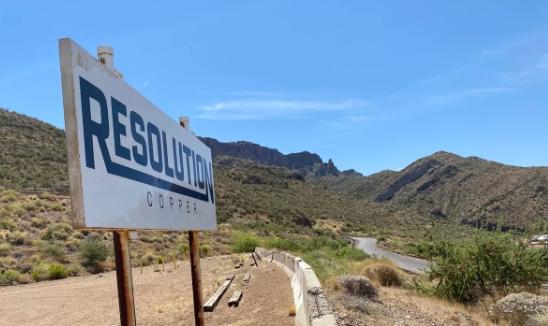
Climate change means the West may need to say no to some mines
Colin Williams, the Mineral Resources Program Coordinator at the U.S. Geological Survey, highlights that the arid conditions of the Western United States were once advantageous for miners.
“With less vegetation and fewer trees,” he explains, “it was more straightforward to conduct mineral resource exploration due to greater exposure of rock formations.”
Furthermore, historical factors shed light on why miners gravitated westward.
“The primary allure of mineral resources in the Western region can be attributed to the historical evolution of the United States,” Williams elaborates. “The West represented a frontier, much of which was designated as public land. The mining law of 1872 provided opportunities for the exploitation of these mineral resources.”
However, contemporary mining technologies have expanded the possibility of locating these critical minerals in regions of the U.S. that are less arid, such as the eastern Appalachians. Williams’ agency recently secured $320 million in funding from Congress for a comprehensive project aimed at assessing the nation’s mineral resources more broadly. Williams notes:
“We are reevaluating areas in the eastern United States that were previously acknowledged as having potential but were not actively pursued, given the predominant focus on the Western U.S.”
Aimee Boulanger, the Executive Director of the Initiative for Responsible Mining Assurance, asserts that the transition to clean energy will inevitably lead to increased mining for these vital metals. However, she emphasizes the importance of instances where state and federal governments may need to decline mining permits in Western states due to water-related concerns. Boulanger remarks:
“There will still be situations where we acknowledge the presence of lithium in the ground but deem it unsuitable for extraction. In a world already grappling with the consequences of climate change, we will need to make choices.” She adds, “What may not be our primary water source today could become indispensable in just five years.”

